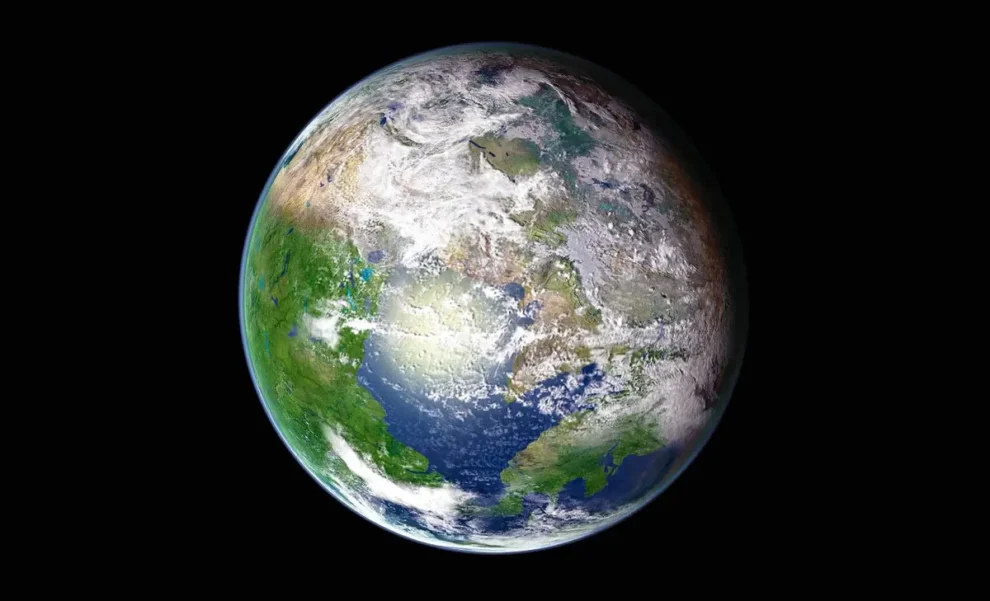A new study suggests that extreme temperatures could lead to a mass extinction event — the first since the dinosaurs died out — that would ultimately end the reign of humans and mammals on Earth.
Dr. Alexander Farnsworth, a Senior Research Associate at the University of Bristol, led the research that paints a grim picture of our planet’s distant future.
Pangea Ultima — future supercontinent
Scientists believe that Earth’s continents are slowly drifting and will eventually come together to form a single massive landmass, called Pangea Ultima.
This supercontinent would drastically change the planet’s climate.
The study, published in Nature Geoscience, uses supercomputer climate models to show how this new configuration could create an environment that’s too hot and dry for most life forms.
Triple threat to life on Earth
So, what’s causing this extreme heat that results in the extinction of humans?
“The newly-emerged supercontinent would effectively create a triple whammy, comprising the continentality effect, hotter sun and more CO₂ in the atmosphere, of increasing heat for much of the planet,” Dr. Farnsworth explained.
First, the formation of the supercontinent would mean more land area far from the cooling effects of the ocean — a phenomenon known as the continentality effect.
Second, over millions of years, the sun will become brighter, emitting more energy and warming the Earth.
Third, increased volcanic activity due to tectonic movements would release more carbon dioxide into the atmosphere, trapping more heat.
“Widespread temperatures of between 40 to 50° Celsius (104 to 122° Fahrenheit), and even greater daily extremes, compounded by high levels of humidity would ultimately seal our fate,” Dr. Farnsworth added.
“Humans — along with many other species — would expire due to their inability to shed this heat through sweat, cooling their bodies.”
Mammals’ heat limitations
Mammals have always been adaptable, surviving various climate extremes throughout history. We’ve evolved features like fur to keep warm and the ability to hibernate during cold spells.
However, our upper temperature tolerance hasn’t changed much. Prolonged exposure to excessive heat is much harder for mammals to handle.
The study suggests that only about 8% to 16% of the land on the new supercontinent would be habitable for mammals.
With most of the planet facing extreme heat and dryness, finding food and water would become nearly impossible.
Current climate action and extinction of humans
While this scenario is millions of years away, the researchers stress that we shouldn’t lose sight of the current climate crisis.
“It is vitally important not to lose sight of our current Climate Crisis, which is a result of human emissions of greenhouse gases,” urged Co-author Dr. Eunice Lo, Research Fellow in Climate Change and Health at the University of Bristol.
“While we are predicting an uninhabitable planet in 250 million years, today we are already experiencing extreme heat that is detrimental to human health. This is why it is crucial to reach net-zero emissions as soon as possible.”
CO₂ levels and tectonic shifts
To estimate future carbon dioxide levels, the team used models of tectonic plate movement and ocean chemistry.
They predict that CO₂ levels could rise from around 400 parts per million today to more than 600 ppm in the future.
“We think CO₂ could rise from around 400 parts per million (ppm) today to more than 600 ppm many millions of years in the future,” noted Professor Benjamin Mills at the University of Leeds.

Of course, this assumes that humans will stop burning fossil fuels, otherwise we will see those numbers much, much sooner.”
“The outlook in the distant future appears very bleak. Carbon dioxide levels could be double current levels,” Dr. Farnsworth added.
“With the sun also anticipated to emit about 2.5% more radiation and the supercontinent being located primarily in the hot, humid tropics, much of the planet could be facing temperatures of between 40 to 70°C (104 to 158°F).”
Implications beyond Earth
This research doesn’t just tell us about Earth’s future; it also has implications for the search for life on other planets.
“This work also highlights that a world within the so-called ‘habitable zone‘ of a solar system may not be the most hospitable for humans depending on whether the continents are dispersed, as we have today, or in one large supercontinent,” Dr. Farnsworth concluded.
Understanding how continental layouts affect climate can help scientists assess the habitability of exoplanets — planets outside our solar system. Could other worlds be facing similar challenges?
Past mass extinctions
The Earth’s geological and climatic history is punctuated by several mass extinction events, moments in time when the planet experienced abrupt shifts, leading to the substantial loss of its biodiversity.
Ordovician-Silurian Extinction (Around 443 million years ago)
In this first notable mass extinction, ice ages predominated and caused substantial marine life loss, wiping out nearly 85% of sea life.
Changing sea levels and temperatures reduced habitat range and induced environmental stress, directly affecting marine biodiversity.
This extinction primarily decimated marine species, since life on land was scarce during this period.
Late Devonian Extinction (Around 360 million years ago)
The Late Devonian extinction left a significant impact, with a 75% reduction in species. This extinction event extensively affected marine life, particularly reef-building organisms and fish.
Volcanic activity and asteroid impacts are considered primary culprits, disrupting ecosystems and altering atmospheric conditions, leading to extensive marine anoxia.
Permian-Triassic Extinction (Around 252 million years ago)
Often referred to as “The Great Dying,” this cataclysm annihilated around 96% of marine species and 70% of terrestrial species.
Massive volcanic eruptions in what is now Siberia released colossal amounts of lava, triggering severe climate change, acid rain, and ocean acidification.
These environmental alterations devastated global ecosystems, transforming life on Earth.
Triassic-Jurassic Extinction (Around 200 million years ago)
This event marked the end of the Triassic and the rise of the Jurassic period, with around 50% of species perishing.
Large-scale volcanic activities and resultant climate changes are believed to be the driving forces, facilitating the dominance of dinosaurs by clearing ecological niches and allowing for adaptive radiations of various species.
Cretaceous-Paleogene Extinction (Around 66 million years ago)
This well-known mass extinction event resulted from a colossal asteroid impact, creating the Chicxulub crater in present-day Mexico and obliterating approximately 75% of all species, including the non-avian dinosaurs.
The impact caused wildfires, tsunamis, and released substantial quantities of sulphur, leading to a “nuclear winter” effect, causing extreme and sudden climate shifts.
Humans, climate, supercontinents, and extinction
Wrapping it all up, this study from the University of Bristol shows that Earth’s future could get so hot that most mammals, including humans, won’t be able to avoid extinction.
The formation of a new supercontinent called Pangea Ultima, a brighter sun, and higher CO₂ levels could crank up the heat to unbearable levels.
It’s a wild thought, but it reminds us that our planet is always changing, and not always in ways that suit us.
When we look back at the mass extinction events throughout Earth’s history, we keep seeing the same story play out.
- Something big happens — like a huge volcano erupts or an asteroid smacks into Earth — and suddenly everything changes, wiping out huge numbers of species.
- The environment shifts so dramatically and quickly that most life just can’t keep up.
- These ancient mass extinctions teach us a pretty sobering lesson about life on Earth: it’s way more fragile than we might think.
As we face our own environmental crisis today, these past events remind us to take better care of our environment and the planet’s biodiversity.
Mother Earth has a wild and predictable history of shaking things up, and we humans — just like all the creatures before us — are really just temporary residents on this ever-changing planet.
















